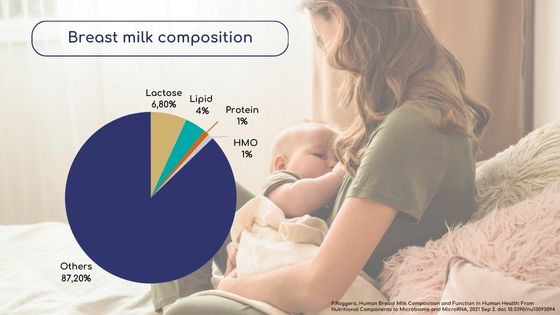
Role and importance of HMOs in infant nutrition
After lactose (6.8%), lipids (4%) and proteins (1%) [1], HMOs are the 4th main component of breast milk, accounting for between 0.5% and 1.5%. These macromolecules play multiple key roles in infant development [2]. It is therefore important to include HMOs in infant nutrition.
The number of studies on these macromolecules is increasing, the main players in the infant milk market are incorporating them into their infant formulations and the number of markets authorising their use is growing (with China as the latest example, having authorised the use of certain HMOs in infant food).
What are HMOs ?
HMOs in breast milk: abundant and highly diverse molecules [2]
Human Milk Oligosaccharides (HMOs) are molecules from the glycan family, present in abundance in the breast milk of different mammals. Not all women synthesise the same types of oligosaccharides. Depending on the lactation cycle, genetic heritage and the mother’s diet, the HMO content and composition of breast milk can vary. It is now estimated that there are over 200 different HMOs in breast milk.
There are several types of HMO, the most common of which are:
- Fucosylated HMOs (2’FL, 3’FL), which represent between 50 and 80% of the HMOs present in breast milk.
- Non-fucosylated or nitrogen-neutral HMOs (LNT).
- Sialylated HMOs (6’FL), which represent between 10% and 20% of the HMOs in breast milk.

The importance of HMOs in infant nutrition [3]
The microbiota is formed during the first few months of an infant’s life. As the development of a rich, diverse, and balanced intestinal flora is crucial to physical and psychological health, it is important to pay close attention to the diet of newborn babies.
There are several factors that influence the composition of the microbiota: the conditions of delivery (vaginal or not, premature or not) and the newborn’s nutrition. Breastfed babies born at term and vaginally generally have a more balanced intestinal microbiota. Conversely, for infants who are not breastfed, or who are born prematurely or by caesarean section, the risks of dysbiosis (imbalance of the microbiota) are higher.
Breastfeeding is therefore recommended because it encourages the development of the intestinal microbiota thanks to the presence of HMOs, molecules that promote the growth of certain specific and beneficial bacterial and microbial strains.

HMOs in baby food
The beneficial effects of HMOs on babies’ growth
The benefits of HMOs for babies’ growth can be seen in several mechanisms.
Firstly, these molecules act as prebiotics in the intestinal microbiota. In fact, most HMOs reach the intestine intact. There, the molecules act as metabolic substrates for beneficial bacteria, the bifidobacteria.
In addition to their prebiotic role, HMOs act as antimicrobials. They play an anti-adhesive role. They bind to epithelial cells, preventing pathogens from attaching themselves to the cells, which are then excreted without causing any symptoms. They can also modify the binding sites and block the molecular interactions that allow pathogens to attach to epithelial cells [4].
HMOs also act as immunomodulators. They have an oligosaccharide structure similar to that of immunoreceptor ligands, enabling them to bind to immune cells. The result is a modification in the production of molecules directly involved in the functioning of the immune system [4].
Finally, these oligosaccharides help brain development. In fact, sialylated HMOs are a source of sialic acid, a nutrient necessary for the proper development of the brain and cognitive abilities of newborn babies [2].
HMOs in the formulation of infant formulas
When breastfeeding is impossible, infant milk formulas are the only alternative available to feed the baby. It is therefore essential that these products ensure food safety for the child and guarantee high-quality formulas that cover their nutritional needs.
The presence of HMOs in infant foods makes it possible to meet the above-mentioned challenges. It has been shown that the addition of 2’FL and LNnT to infant milk formulations improves the development of the microflora of newborn babies4. These molecules encourage the preferential development of beneficial bacteria such as Bifidobacteria.
To find out more: providing appropriate nutrition for optimal infant growth.

Industrial processes for producing HMO
In 2021, less than 50% of mothers were exclusively breastfeeding their children when they left the maternity hospital [5]. However, the WHO recommends breastfeeding as the sole source of nutrition for children up to the age of 6 months. One of the challenges facing producers of infant milk formulas is therefore to enrich them with HMOs, the bioactive molecules required for healthy infant growth. To achieve this, two industrial processes are used [6]:
- Enzymatic fermentation: using glycosyltransferases from pathogenic bacteria such as Helicobacter, Neisseria or Pasteurella to synthesise HMOs.
- Microbial fermentation: using lactose as a substrate for bacteria such as E. Coli, S. cerevisiae or Lactococcus Lactis, followed by purification of the molecules obtained by selective concentration (e.g. nanofiltration).
Lactalis Ingredients is aware of this challenge and offers a range of lactose powders dedicated to infant formulations and the manufacture of lactose derivatives such as HMOs. This lactose, the substrate used to produce HMOs, is a high-purity lactose (white, lactose content > 99.2%) with a specific microbial quality to ensure that the bacterial strains used to produce HMOs do not mix with those present in the substrate during fermentation.
Sources:
[1]P.Roggero, Human Breast Milk Composition and Function in Human Health: From Nutritional Components to Microbiome and MicroRNA, 2021 Sep 2. doi: 10.3390/nu13093094
[2] Bode L. Human milk oligosaccharides: every baby needs a sugar mama. Glycobiology. 2012 Sep;22(9):1147-62. doi: 10.1093/glycob/cws074. Epub 2012 Apr 18. PMID: 22513036; PMCID: PMC3406618.
[3] Mueller NT, Bakacs E, Combellick J, Grigoryan Z, Dominguez-Bello MG. The infant microbiome development: mom matters. Trends Mol Med. 2015 Feb;21(2):109-17. doi: 10.1016/j.molmed.2014.12.002. Epub 2014 Dec 11. PMID: 25578246; PMCID: PMC4464665.
[4] Wiciński M, Sawicka E, Gębalski J, Kubiak K, Malinowski B. Human Milk Oligosaccharides: Health Benefits, Potential Applications in Infant Formulas, and Pharmacology. Nutrients. 2020 Jan 20;12(1):266. doi: 10.3390/nu12010266. PMID: 31968617; PMCID: PMC7019891.
[5] Cinelli H., Lelong N., Le RayInserm C, Enquête nationale périnatale Rapport 2021, Inserm, 2022 Oct
[6]Zeuner B, Teze D, Muschiol J, S.Meyer A, Synthesis of Human Milk Oligosaccharides: Protein Engineering Strategies for Improved Enzymatic Transglycosylation, 2019 May 28. doi: 10.3390/molecules24112033















